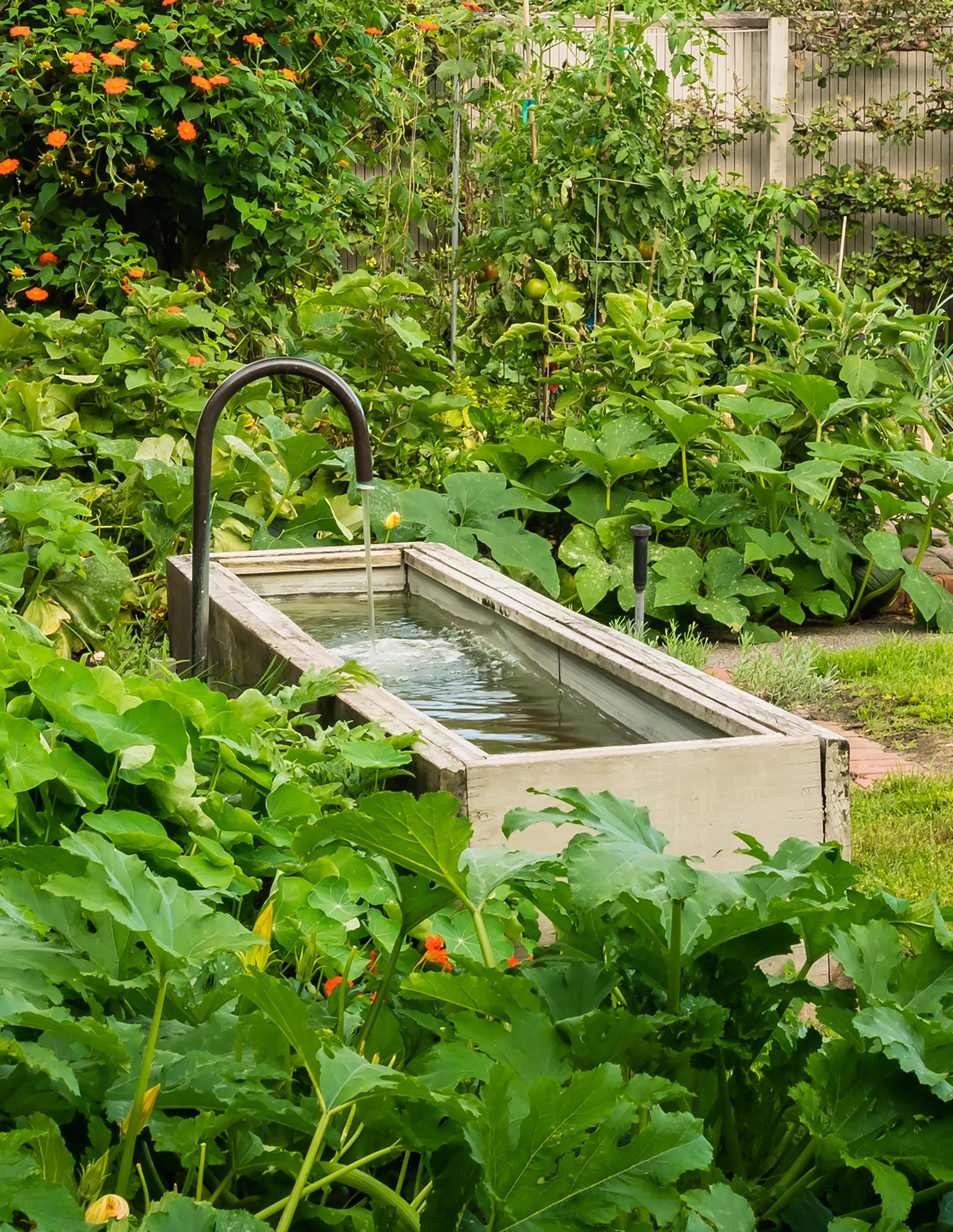
Celebrate the beauty of late summer at the Arboretum! AUGUST/SEPTEMBER 2023
arboretum magazine
FROM THE EXECUTIVE DIRECTOR
ANDREW GAPINSKI
The Arboretum is alive with color! After a terrific spring, the gardens and grounds have now taken on a new life with spectacular late-blooming perennials beginning their show and the annual gardens overflowing with flowers, foliage and whimsy after a summer of sun and expert care from our staff and volunteers.
If you haven’t paid us a visit recently, be sure to stop by again soon to see the late-summer splendor of asters (page 4), and later, for the showy autumn foliage of staghorn sumac (page 5). Both plants are beneficial to pollinators and other wildlife and reach the peak of their beauty this time of year.
It’s been fun experiencing the Arboretum with my family this summer,
AUGUST/SEPTEMBER 2023, VOL. 42, NO. 4
and my kids are enjoying exploring and getting messy at Summer Day Camps. The Arboretum offers so many great opportunities for both kids and adults to learn new skills and spend time in nature this season. Browse our upcoming classes on pages 14-15.
We’re also looking forward to the opening of our AppleHouse in late August and to celebrating the ongoing work of the researchers and staff at the Horticultural Research Center, which introduced the Honeycrisp apple more than 30 years ago! Read more about the legacy of the Honeycrisp on page 6. And don’t miss the Arb Glass Pumpkin Patch, hosted by the Arboretum Auxiliary Sept. 15-17, filling the gardens outside the Snyder Building with more than 5,000 glass pumpkins and glass garden art, all for sale in support of the Arboretum.
Thank you to everyone who has made me feel welcome over the past few months while I get to know the Arboretum, our staff and volunteers, and of course, our members and visitors! I’ve enjoyed watching the gardens and grounds transition from spring to the height of summer, and I invite you to come for a visit to see for yourself the beauty of the harvest season at the Arboretum.

Minnesota Landscape Arboretum Magazine is published six times a year by the Minnesota Landscape Arboretum. The Arboretum is part of the College of Food, Agricultural and Natural Resource Sciences (CFANS) at the University of Minnesota. The magazine is a benefit of Arboretum membership. To request a copy of this publication in an alternate format, please call 612-301-1257.
© 2023 Regents of the University of Minnesota. All rights reserved. The University of Minnesota is an equal opportunity educator and employer.
Elise Bremer, Editor
Brenda Drake Lesch, Art Director
Andrew Gapinski, Executive Director
Timothy S. Kenny, Director of Education

Susan Taylor, Ph.D., Director of Advancement
Matthew Clark, Ph.D., Director of Research
Tom Lany, Marketing, Communications & PR Manager
Glenn Stolar, President, Arboretum Foundation arb.umn.edu 612-624-2200 arbinfo@umn.edu
| ARBORETUM MAGAZINE // AUGUST • SEPTEMBER 2023 2
On the cover: The Home Demonstration Gardens burst into life in late summer. Photo by Mark MacLennan.
Photo by Mark MacLennan
The Garden for Small Spaces in the Home Demonstration Gardens is a showcase of edible and ornamental annuals.
In the Arboretum’s sun-drenched Home Demonstration Gardens, hot summer days lead to a plentiful harvest come mid-summer. These gardens showcase inspirational and attainable ideas that visitors can recreate in their own gardens, with a focus on growing fruits, vegetables and herbs suited to backyards, patios and small spaces.
Landscape gardener Ted Pew has been the steward of these gardens since 1987, and designs them to be functional, educational and ornamental. And by August, every border and raised bed is bursting with texture, color and of course — vegetables, including prehistoriclooking kale and chard, rhubarb, squash, tomatoes and more. Even flowering plants — including pollinator favorites such as gaillardia — are represented in the beds. Adding flowering plants to fruit and vegetable gardens not only adds a pleasing visual element, but also attracts pollinators that are essential for fruit production in many vegetables, including squash and cucumbers.
So what makes for such an abundant harvest in the Home Demonstration Gardens? For Pew, success comes down to making the
right selections at the beginning of the season, including seeds from All-America Selections and Master Gardener Seed Trial winners. The Arboretum is proud to be an All-America Selections Display Garden, featuring AAS winners throughout the gardens that have been trialed by horticulture professionals in different zones throughout the country, making every plant a tried-and-true choice for home gardeners. This year’s gardens will feature 2001 AAS winner ‘Giant Marconi’ Italian sweet pepper and 1979 winner ‘Queen Sophia’ marigold.
With all the sun, heat and TLC from Arboretum staff, visitors are likely to see an abundance of gorgeous produce growing throughout the garden. The garden-fresh produce from the Home Demonstration Gardens goes into summer menu items at the Eatery at the Arboretum and to Arboretum staff and volunteers to snack on after a long day in the gardens.
Stop by the Home Demonstration Gardens on your next visit to the Arboretum for inspiration on growing your own tasty — and eye-catching — produce at home!
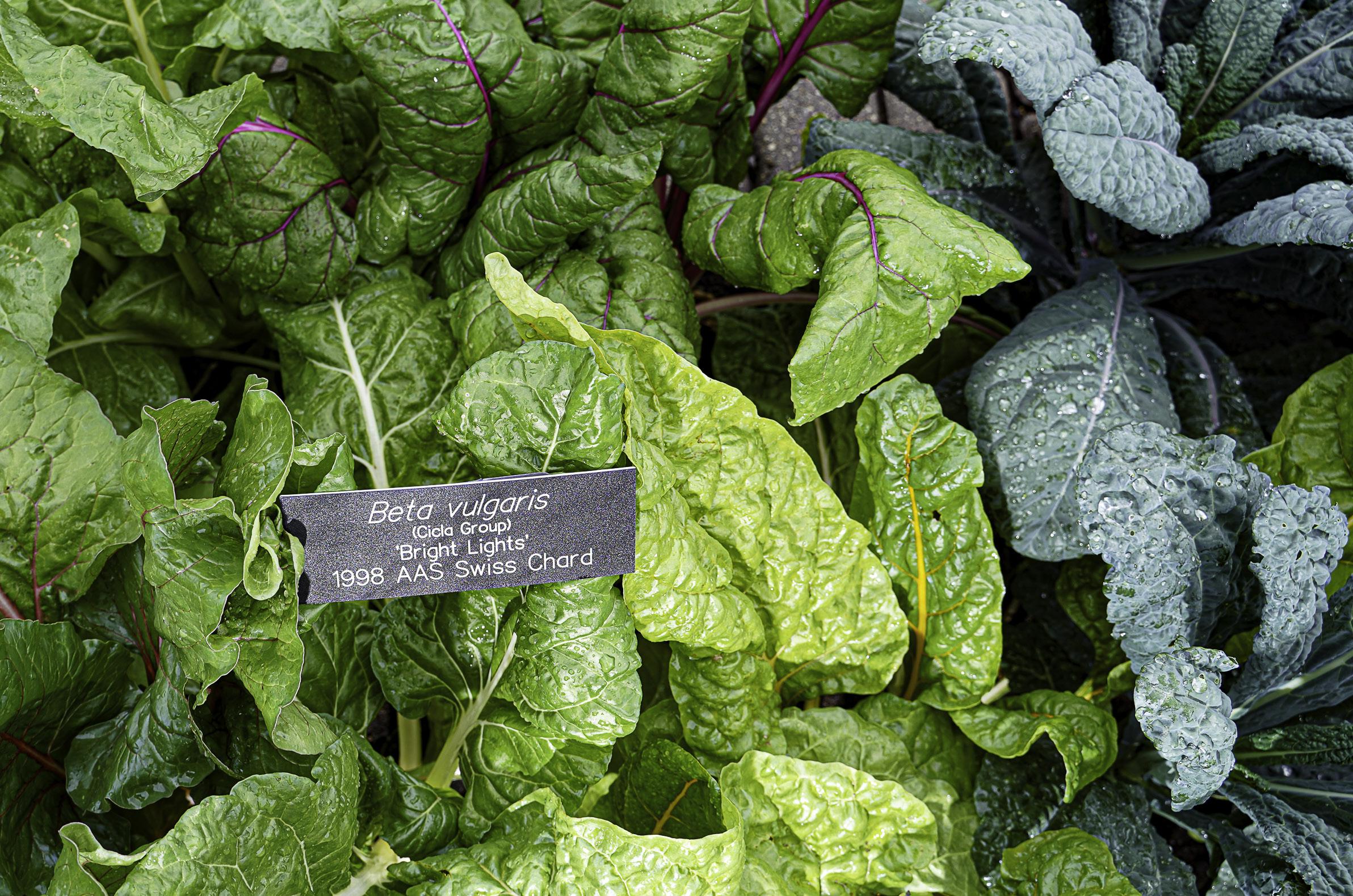
ARBORETUM MAGAZINE // AUGUST • SEPTEMBER 2023 | 3
SEASONAL BOUNTY
ELISE BREMER • EDITOR
Photo by Norbert Lucas
ALAN BRANHAGEN • CONTRIBUTING WRITER
Asters are one of our most colorful and reliable late summer and fall flowers in Minnesota. Did you know they are also one of the most critical plants for pollinators? There are many native bees that are aster specialists that will only feed their young nectar and pollen from asters or a few closely related plants. Asters are also an important source of nectar for a whole host of other insects, including migrating monarch butterflies.
The name aster is derived from the Ancient Greek word for “star.” A prairie, wetland, woodland or garden studded with asters is surely as stunning as a starry night sky. What we think of as an individual flower is actually a head composed of multiple flowers. The central “disk flowers” are arranged in a unique compressed spiral, the number of flowers corresponding to
the Fibonacci sequence — or golden ratio — for maximum efficiency.
The disk flowers are yellow, changing to pink or darker colors when pollinated — while the flowers around the edge are called “ray flowers” and feature a colorful ray that forms the “petals” of this entire flower cluster. Picture a daisy — cousin to the aster. When you pull off the petals saying, “she loves me, she loves me not,” you are actually pulling off the rays!
There are many native Minnesota species of asters that thrive in a variety of habitats. Whatever the conditions in your garden, there is an aster for your landscape! Further research into this group of flowers has led botanists to divide Aster into several genera — with some referring to the “aster disaster” — which includes an array of tough-to-pronounce botanical names
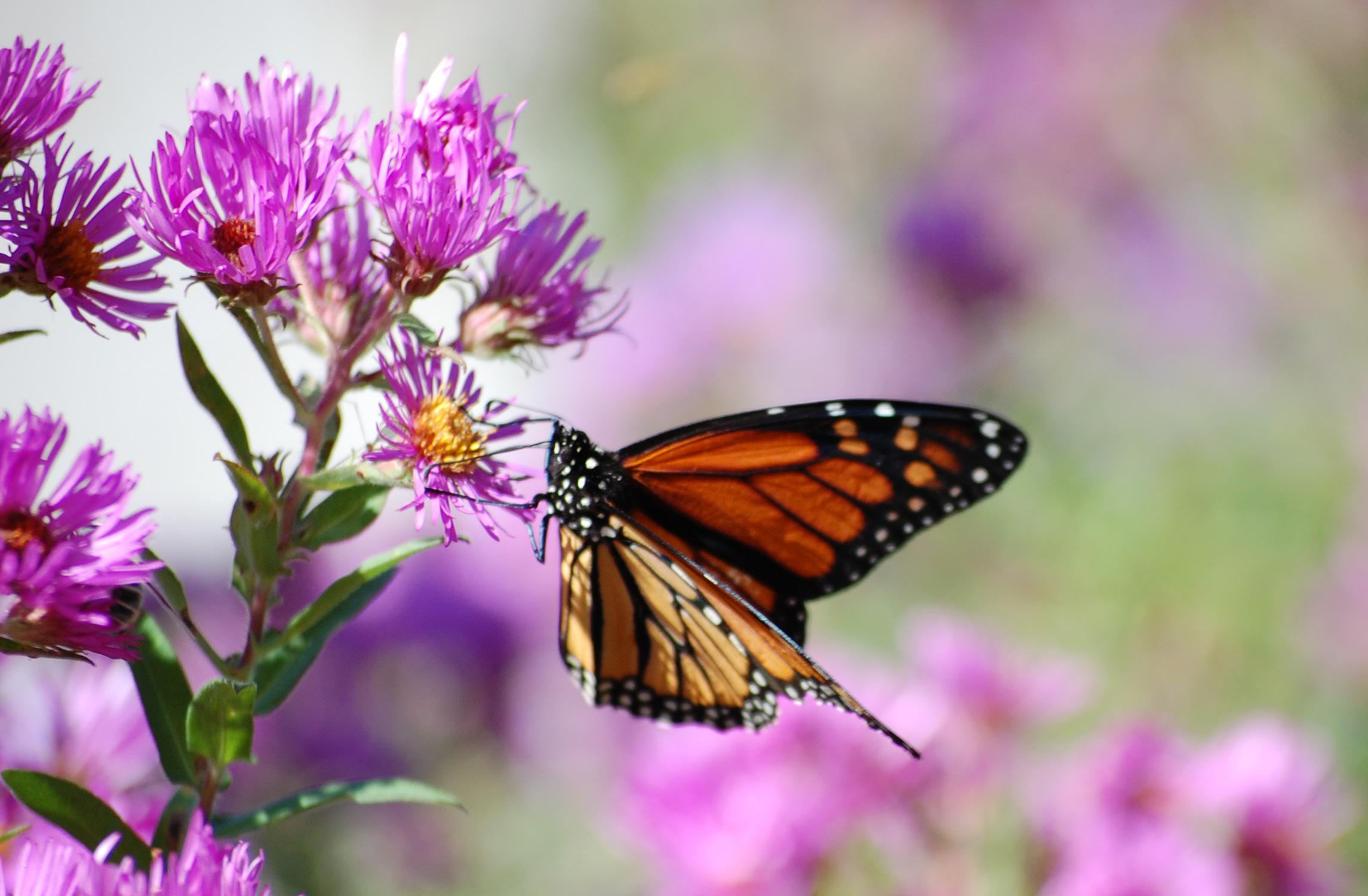
including Symphyotrichum, Doellingeria, Eurybia, Canadanthus, Oligoneuron and Ionactis
Native asters are the most popular, but garden hybrids — mainly derived from the East Coast species including New York aster (S. novi-belgii) — are becoming more popular to sell along with mums in the fall. Be sure to plant only the singleflowered forms as the full doubles do not provide nectar and pollen for pollinators that rely on asters as a primary food source.
Different types of asters are suited to a surprising array of sites. Visit the Arboretum’s Nature Notes blog at z.umn.edu/asters-mn to learn about types of asters for different sites, including varieties for sunny, dry sites and rock gardens; varieties for wet soils or common garden soils; as well as woodland/shadeloving asters.
| ARBORETUM MAGAZINE // AUGUST • SEPTEMBER 2023 4
HORTICULTURE
Asters provide an important source of nectar for migrating monarch butterflies.
Photo by Johanna DeBuhr
MATT SCHUTH • NATURALIST
The spectacular golden-orange harvest moon that appears above the eastern horizon near the time of the autumnal equinox reminds us of Jack-olanterns and giant pumpkins. Native peoples called it the “corn moon,” a time to gather the crops of wild rice, beans, squash, pumpkins and corn, and a time of tranquility to reflect upon the passing seasons. But the fall season is most noted for its lustrous glow of leaf change as forests and roadsides are set ablaze in multicolored hues.
Albert Camus said, “Autumn is a second spring when every leaf is a flower.” Hidden amongst the verdant green vegetation of summer, the staghorn sumac often goes unnoticed until it explodes onto the autumn scene with its radiant leaves of scarlet, saffron and gold — as if spilled from an artist’s palette. Its candelabra-shaped branches hold
plush, red fruit and fuzzy twigs resembling deer antler velvet.
Indigenous peoples found uses for all parts of the sumac. The fall fruit clusters were rubbed and steeped in water to create citrus pink lemonade, a favorite in many traditions, while the Mi'kmaq peoples made a fruit tea for sore throats and the Chippewa peoples, a flower tea for stomach pain. The inner bark and roots provided yellow and gray dyes for clothing while the astringent materials from the bark and leaves were used for tanning leather. The soft pith stems were hollowed out and used as spiles for tapping maple trees.
Nearly 100 species of birds feed on sumac fruits, often at a time when other food sources are at a minimum. Pheasants, turkeys, grouse, robins and cardinals are some of our overwintering birds that take advantage of the abundance of sumacs. Sumac bark, as with other shrubs, can be
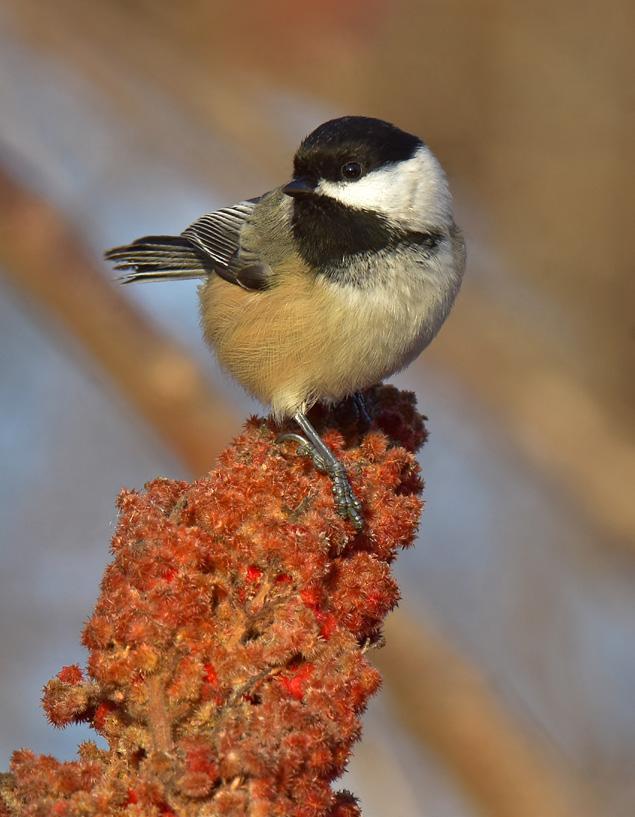

NATURE FOCUS
girdled and damaged by rabbits. The seeds — consumed by cottontails and eliminated in pellet form — germinate at a much higher rate than uneaten seeds. White-tailed deer browse on twigs and stems, and a number of pollinating bees and wasps use sumacs to build nests and lay eggs. Staghorn sumac is a gift of nature benefiting many species, and its brilliant colors illuminate the autumn landscape and bring us great joy.
ARBORETUM MAGAZINE // AUGUST • SEPTEMBER 2023 | 5
Staghorn sumac illuminates the landscape in the fall and provides food and habitat for wildlife.
Photos by Nature by Travis Bonovsky
It’s hard to believe that the Honeycrisp apple was introduced more than 30 years ago, and that the cross pollination that produced it was made more than 60 years ago! Since its introduction, Honeycrisp has been a game-changer in the apple industry. Now at No. 3 in U.S. apple production, it’s the first variety from a U.S. breeding program to crack the top six. Other apples in the top six were all found as chance seedlings — including Red Delicious, Golden Delicious and Granny Smith — or were bred in other countries — such as Gala and Fuji.
Honeycrisp helped change U.S. fresh apple consumption and consumer expectations on quality and pricing for a premium apple. Honeycrisp was introduced in the 1990s, when the U.S. apple industry was at a low point with
old varieties, low pricing and overproduction. Few new plantings were being made. In fact, during the 1990s fruit tree nurseries could not even sell all their Honeycrisp trees and thousands went to the burn pile as they waited for their popularity to take off.
However, Honeycrisp was being planted in Minnesota orchards and was catching on as a favorite. Minnesotans tasted it at local orchards, farmer’s markets and eventually in supermarkets. They loved it — even with exceptional pricing that was often 50% higher than other varieties.
Growers and supermarkets across the U.S. quickly took notice. In the 2000s, Honeycrisp became widely planted in orchards, and was introduced to consumers across the country. Even with production growing to more than 30 million bushels in 2021, the retail price has
remained high due to its popularity and strong demand.
The popularity of Honeycrisp in the U.S. has not gone unnoticed, with breeders around the world using it as a parent in their breeding programs. Although Honeycrisp will probably be a major variety for several decades, perhaps its most important legacy will be its genetic contribution to future varieties into the next century. Several of its children are already in supermarkets and you may recognize some by their trademark names — Cosmic Crisp, Snapdragon, Pazazz and Evercrisp.
Come visit the AppleHouse this fall at “The Home of Honeycrisp,” the Horticultural Research Center at the Arboretum, to snack and stock up on Honeycrisp and its Minnesota children — First Kiss® and SweeTango®.
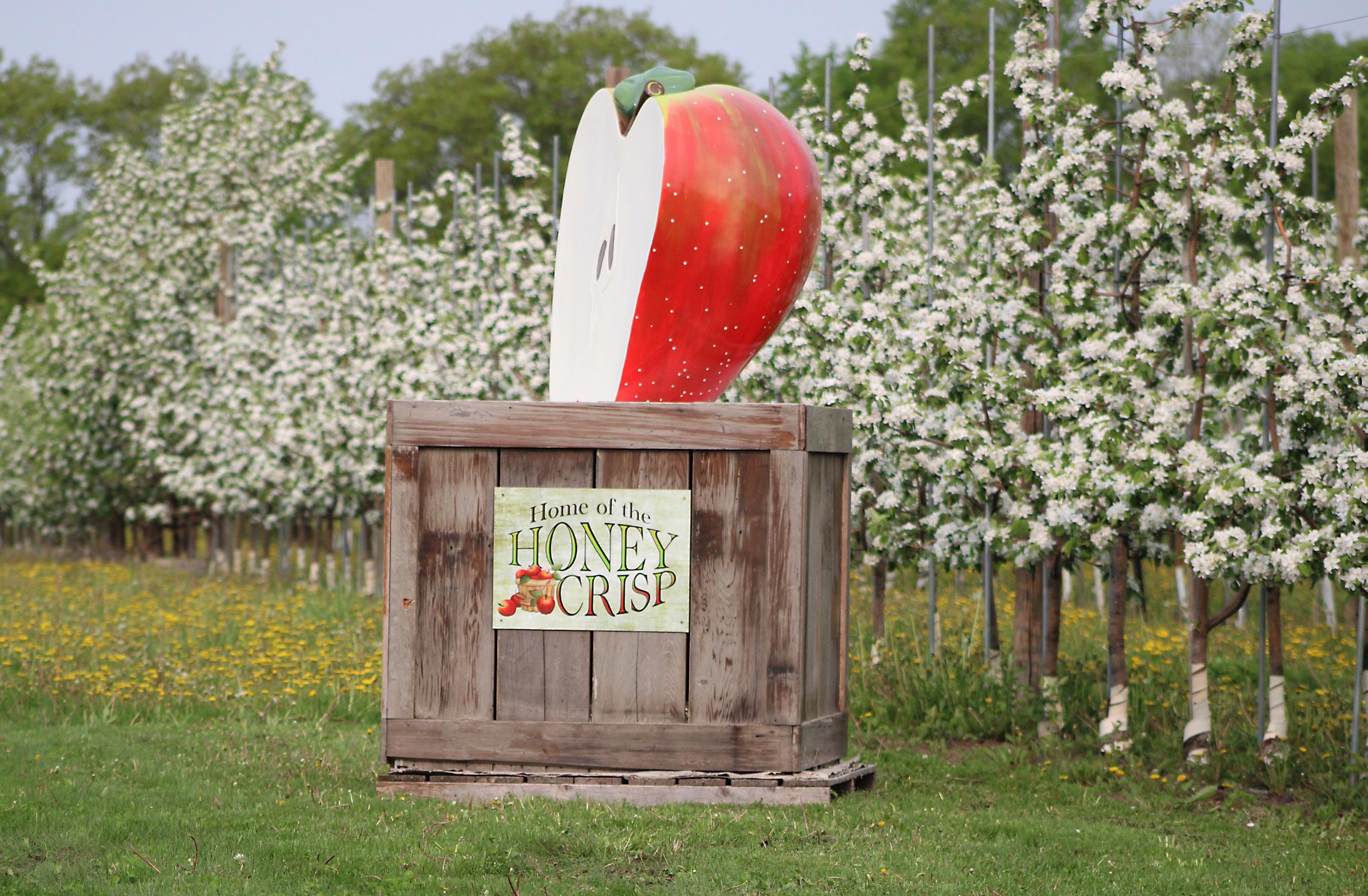
| ARBORETUM MAGAZINE // AUGUST • SEPTEMBER 2023 6 RESEARCH
JIM LUBY • PROFESSOR, DEPARTMENT OF HORTICULTURAL SCIENCE, UNIVERSITY OF MINNESOTA
Flowering trees in spring bring apples in the fall at the Horticultural Research Center — the “Home of the Honeycrisp.”
Photo by Johanna DeBuhr
JEFF ISEMINGER • CONTRIBUTING WRITER
It’s more than a mere rest stop — it’s a pocket of peace — bathed by the sound of wind stirring the nearby pines. This new rest stop sits atop a hill on the recently extended Highway 5 Regional Trail, just east of the Arboretum gatehouse. It’s sheltered from the noise of Highway 5 by majestic pines, and graced by the kaleidoscopic colors of azaleas in the springtime.
The rest stop is a gift to the Arboretum from Sharon and Bob Moeller, in memory of their son Mark. “He loved the outdoors,” said Sharon. “We’re an outdoor family,” said Bob, “so the Arboretum is a great extension for us.”
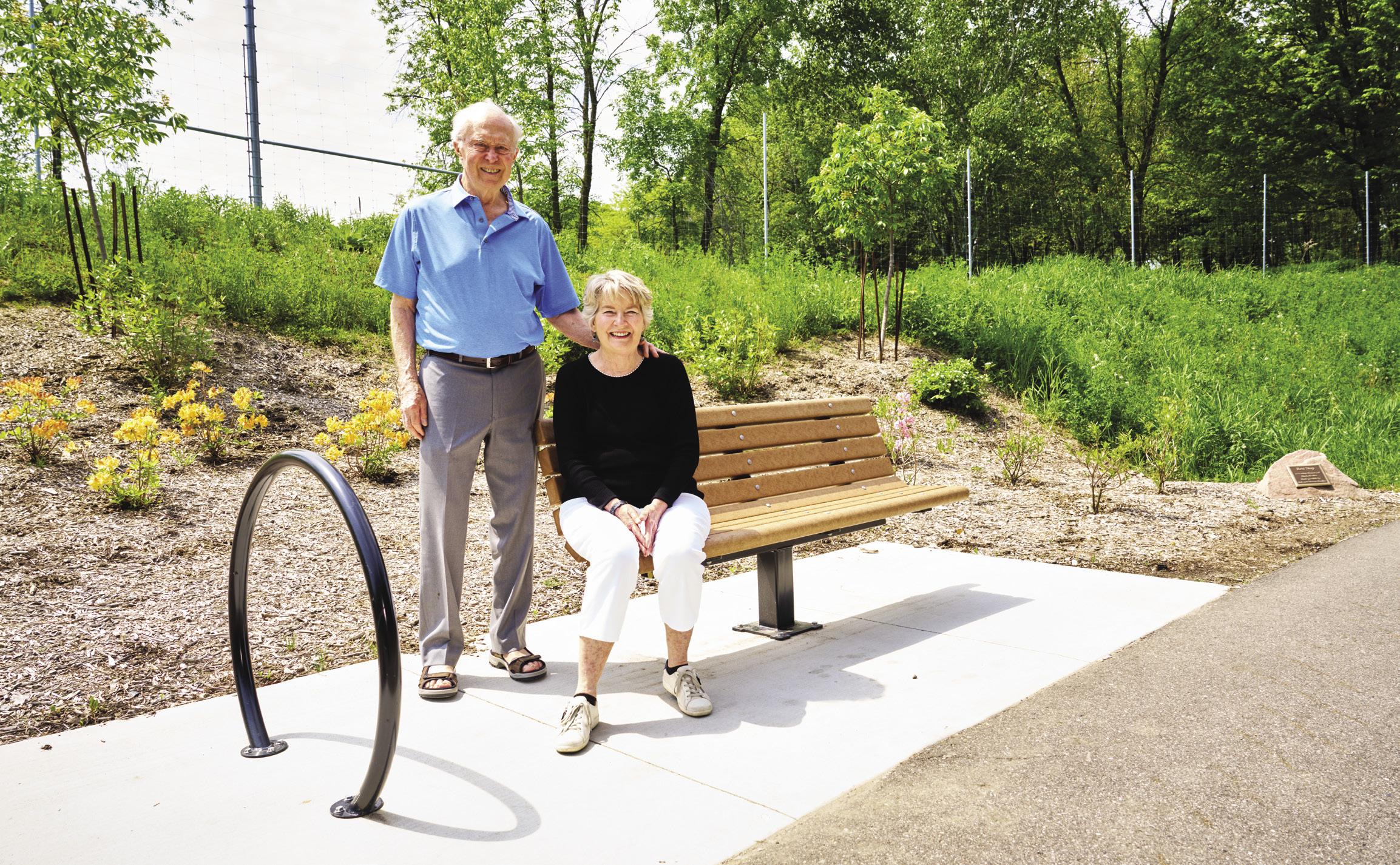
They ski, waterski, canoe and, yes, bicycle. They’ve been coming to the Arboretum since
they moved to the Jonathan neighborhood of Chaska, where they’ve lived in the same midcentury home for half a century.
“We love the Arboretum,” said Sharon. “It’s a place for all people for all seasons. We brought our kids, nieces and nephews to the Arboretum to see things like frogs and sunrises.” The Moellers are lifelong learners, so they’ve soaked up knowledge from the Arboretum’s classes, the Andersen Horticultural Library and the real-life botanical library that spreads across the grounds at the Arboretum, from which you can check out plants to consider for your own yard.
The choice of azaleas for the rest stop was not happenstance. “I have been smitten by
azaleas,” said Bob, “since I first saw them at the Masters golf tournament.” Those Georgiaplanted azaleas would not survive, let alone thrive, in the icy climes of Minnesota. So how lucky for the Moellers and others that the Horticultural Research Center developed the cold-hardy ‘Lights’ series of azaleas, some of which are planted at the rest stop.
There’s another reason the location is special for the Moellers: Bob serves on the Met Council’s Parks and Open Space Committee, which is instrumental in extending the regional trail along Highway 5. The bench on the hill among the pines is a gift of rest for the travelers of today and beyond, said Sharon: “It’s such a joy to pass on to future generations.”
ARBORETUM MAGAZINE // AUGUST • SEPTEMBER 2023 | 7
THE JOY OF GIVING
Bob and Sharon Moeller funded the new rest stop on the Highway 5 Regional Trail as a gift to the Arboretum in memory of their son Mark Moeller.
Photo by Robert Evans Imagery
Create a healthy environment in your yard rather than a perfect landscape
ELISE BREMER • EDITOR
Imagine a garden without the buzzing, flitting and fluttering of insects moving from flower to flower in search of food. It’s hard to picture such a lifeless landscape! Insects such as bees, butterflies, beetles, wasps and even ants, are pollinators. By foraging for food, pollinators carry pollen from one plant to another, fertilizing plants and enabling them to make fruit or seeds. Bees — including more than 400 bee species native to our state and the European honeybee — are the most efficient pollinators thanks to their fuzzy bodies and behavior, and are critical to maintaining the diversity of the plant world and our food crops.
While the gardens and grounds at the Arboretum provide a buffet of food sources and habitat for pollinators, each of us can support pollinators in our own outdoor spaces, no matter the size. Whether you have a
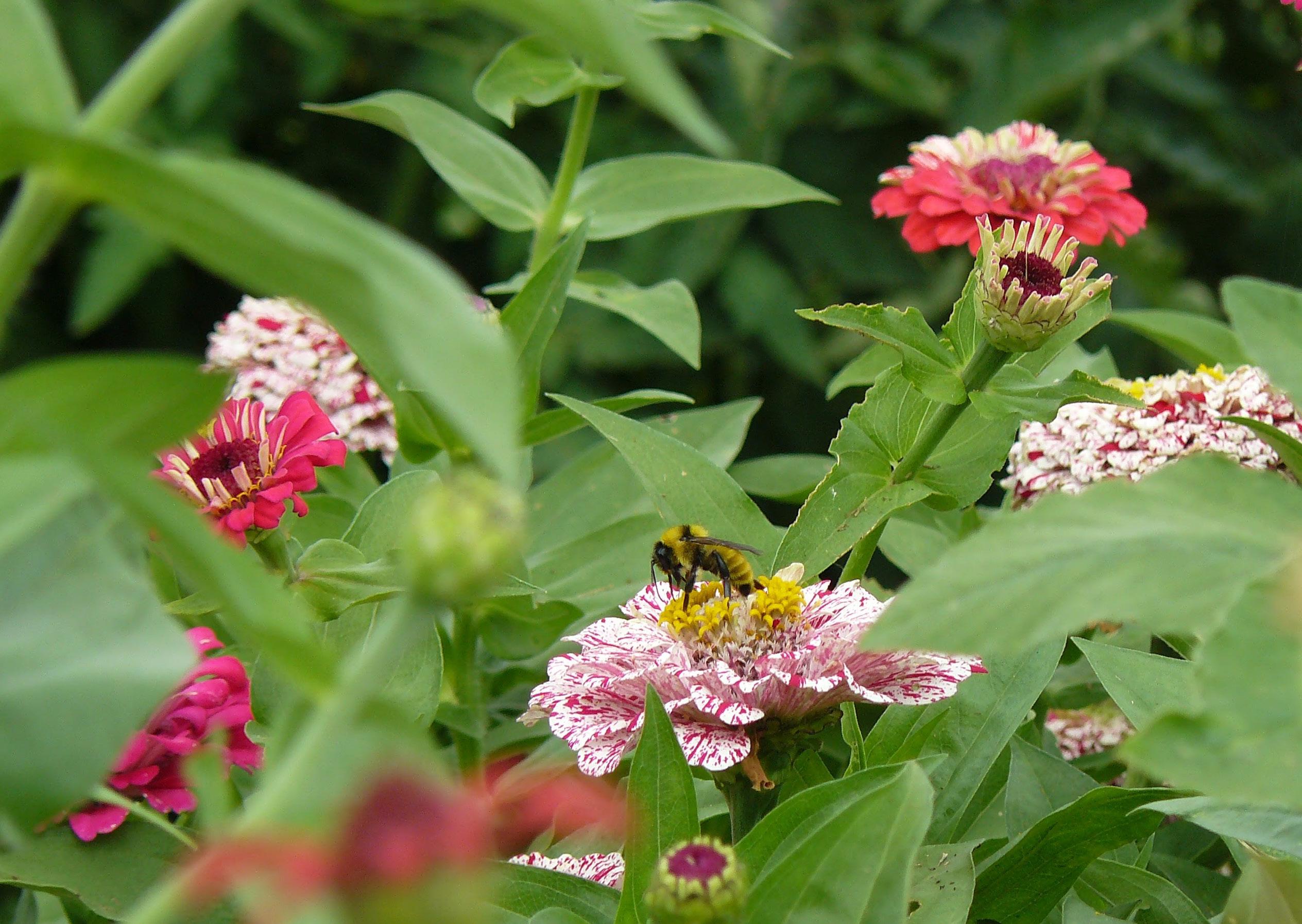
large, well-established garden or just a few containers on the patio in the summer months, you can create an outdoor space that supports pollinators year-round by growing a diverse array of flowering plants rich in pollen and nectar, leaving habitat and nesting sites available to pollinators and eliminating the use of pesticides in your garden.
Native plants are often preferred by pollinators, but they aren’t required, said Julie Weisenhorn, a University of Minnesota Extension horticulture educator. “There’s room in gardens for all types of plants — native, nonnative and native cultivars — in our landscapes,” she said. “However, native plants have evolved with native insects to provide quality pollen and nectar and habitat that they need.”
The National Wildlife Federation advises the goal of having at least
| ARBORETUM MAGAZINE // AUGUST • SEPTEMBER 2023 8 HORTICULTURE
Annual flowers such as zinnias provide instant color and a source of pollen and nectar for butterflies and bees.
Photo by Julie Weisenhorn
50-70% native plant material (in terms of biomass) in our landscapes including a diversity of plant types. “We want to encourage people to grow plants that benefit pollinators,” said Weisenhorn. “This includes flowers, annuals, perennials, biennials, trees and shrubs and bee lawns.”
Planting a wide variety of plants also ensures that foraging pollinators can find food in your garden throughout the growing season. “Try to plan your landscape so plants for foraging bees are blooming from April through October. This can be difficult in Minnesota, especially in April,” Weisenhorn said. “Fortunately, there are native plants such as bloodroot (Sanguinaria canadensis) that bloom early in the season. You can also plant bulbs such as crocus and grape hyacinth (Muscari armeniacum) for early season bees.”
As gardens transition into late summer, leaving behind stems and seed heads, focus less on cutting back perennials and “cleaning up” garden beds and more on supporting pollinators. Leaving dried stems and seed heads standing on perennials provides habitat for stem-nesting bees and food


for wildlife in the winter months — and adds winter interest to otherwise dreary snow-covered garden beds.
If you feel the need to remove some stems, cut them back to varying heights (8”-24”) and place the cuttings in a pile where stem-nesting bees can find them or continue to nest in them until they emerge in spring. Other pollinators — including most native bee species — nest in the ground. Leave some areas of open soil available in your landscape to provide habitat and ground-nesting sites. Likewise, leaving leaf litter in garden beds in the fall creates excellent habitat for pollinators, and acts as a natural mulch that will add carbon to the soil as the leaves break down.
Lastly, avoid using pesticides — which include insecticides, fungicides and herbicides — in your garden. Pesticides are harmful to pollinating insects, and most home landscapes can function without them. “Many issues such as leaf spot diseases can be avoided with good cultural practices, such as watering at the base of the plant instead of overhead sprinkling and spacing plants based on mature size to allow for airflow and light all around and throughout the plant,” Weisenhorn said.
For those just getting started making a more pollinator-friendly landscape, Weisenhorn recommends not trying to overhaul everything at once. “Think of landscape projects in phases. For example, start by looking for pollinator plants as you add to your landscape and replace plants that aren’t performing well. Adopt good cultural practices that make your yard and garden pollinator-friendly. Consider converting part of your yard — like the backyard — to a bee lawn, so you can experiment and learn without the whole neighborhood watching. Kind of see how it works for you.”
Weisenhorn also recommends checking out classes and research-based resources from the Arboretum, Extension and the Xerces Society. Learn more at the Tashjian Bee and Pollinator Discovery Center and online at arb.umn.edu/bees-pollinators. “Our landscapes — and our lives — would be very different without pollinators,” said Weisenhorn. “We all need to do whatever we can to create habitat and provide food that helps them thrive.”
ARBORETUM MAGAZINE // AUGUST • SEPTEMBER 2023 | 9 HORTICULTURE
A variety of flowering plants attract pollinators to the Home Demonstration Gardens.
The Garden for Pollinators at the Tashjian Bee and Pollinator Discovery Center.
Photo by Sarah Jackson
Photo by Jason Boudreau-Landis
Stock up on apples, treats, pumpkins and gourds at the AppleHouse, opening in late August, depending on apple availability. The AppleHouse is located just down the road from the Arboretum’s main entrance at 7485 Rolling Acres Road next to the Horticultural Research Center. Shop a variety of popular University of Minnesota apple introductions, including Honeycrisp, SweeTango® and First Kiss®. Don’t miss the Holiday Boutique at the AppleHouse, opening in November. All proceeds help support Arboretum research and operations. Check arb.umn.edu/ apple-house for updates.

STORYTIME IN THE LIBRARY
Aug. 25 and Sept. 29, 10:30-11:30 a.m. Join us on the last Friday of each month for StoryTime in the Andersen Horticultural Library. Celebrate plants and nature and foster a love for books and reading by diving into the library’s vast collection of children’s books. StoryTime is recommended for ages 0-5, but all are welcome. Learn more at arb.umn.edu/storytime.

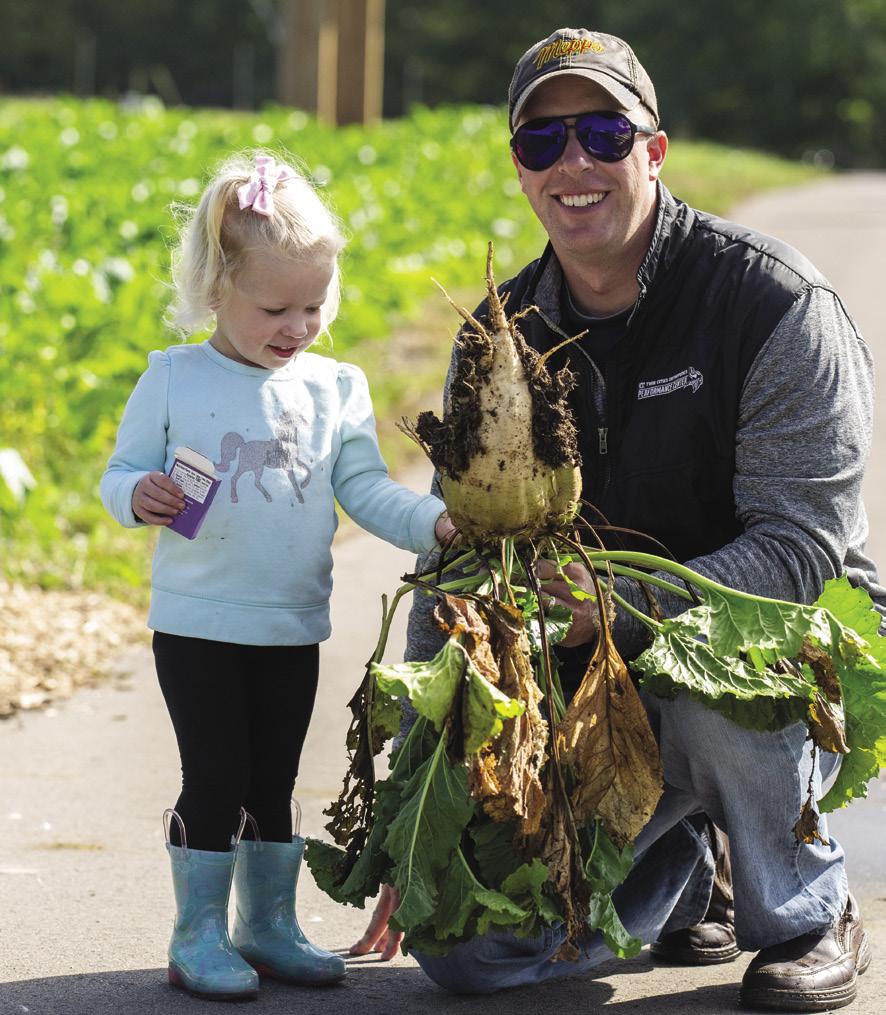
MUSIC IN THE GARDENS
Thursdays 6-7:30 p.m. and Sundays 1:30-3 p.m. Enjoy live music throughout the summer at the Ordway Picnic Shelter overlooking Green Heron Pond. Local bands and community groups will perform a wide range of musical styles. Bring a blanket or lawn chair for seating. This event is included with daily ticketed admission. See the lineup at arb.umn.edu/musicinthegardens

FIELD FEST 2023
Sept. 9, 10 a.m.-3 p.m.
Tour the Farm at the Arb and celebrate Minnesota farmers and the harvest season with live music, food trucks and a beer garden. Visitors will have a chance to harvest or process a Minnesota crop; meet Minnesota food growers and producers and learn about their work; and get a taste of Minnesota through plant-toplate cooking demonstrations and samples. Learn more at arb.umn.edu/fieldfest.
Presented by
AL L ABOUT DOGS DAY
Aug. 12, 9 a.m.-1 p.m.
Though dogs aren’t allowed in the main gardens at the Arboretum, they’re the stars of the 65-acre Dog Commons, an on-leash dog trail designed by the Arboretum’s Nature-Based Therapeutics experts. And on this day, the Arb invites dog owners to come together to walk the trails, heel for photos and meet other dog-lovers. A Pet Expo features 40 pet vendors, while events include a scavenger hunt, contests (cutest dog, best trick, best costume), agility demos and prizes. Register for the events and contests at arb.umn.edu/events/allaboutdogsday

ART IN THE GARDENS
Aug. 18, 4-8 p.m. and Aug. 19-20, 10 a.m.-4 p.m. At this unique showcase of art and nature, visitors and artists can mix, mingle, stroll, eat, shop and hear live music. High-quality products include artisan foods, handmade jewelry, nature-inspired art and spa-worthy bath and body products. Learn more at arb.umn.edu/events/artinthegardens.

| ARBORETUM MAGAZINE // AUGUST • SEPTEMBER 2023 10 EVENTS
APPLEHOUSE
Photo by Susie Hopper
Photo by Katie Knapp
Photo by Karen Blenker
Photo by Mary Ann Land
Photo by Karen Blenker
ARB GLASS PUMPKIN PATCH
Sept. 15-17
Experience the magic of the Arb Glass Pumpkin Patch set against the fall splendor of the Arboretum’s gardens. Browse over 5,000 glass pumpkins, art pieces and garden art from 12 award-winning, professional glass artists, who will offer free glass-blowing demonstrations daily. Your purchase of these unique art pieces supports the Arboretum and the artists. This event is included with daily ticketed admission but space is limited. Make a reservation starting Aug. 2 for Arb members and Aug. 4 for the nonmembers. Learn more at arb.umn.edu/events/ glass-pumpkin-patch or call 612-625-9865.

AUTUMN YOGA RETREAT
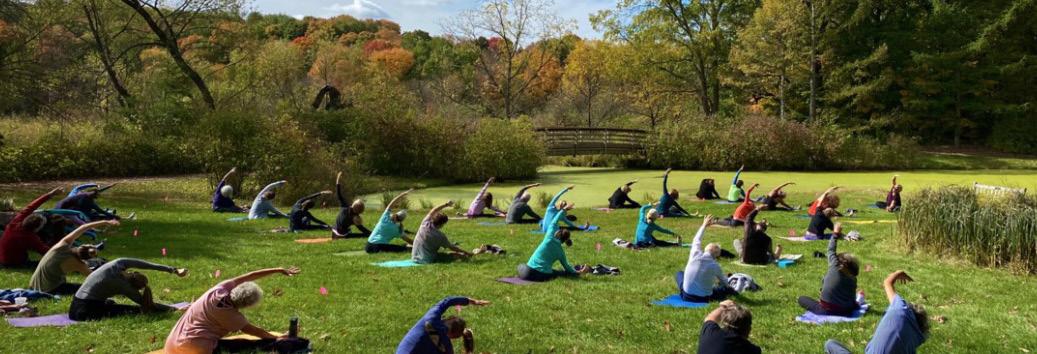
Sept. 16, 9 a.m.-3:45 p.m.
Relax your mind, body and spirit while embracing the start of the fall season at the Arboretum's Autumn Yoga Retreat. Start the day with a light breakfast at the Learning Shelter near the Red Barn at the Farm at the Arb, followed by three different class rotations with a break for lunch. The retreat will close with a blissful yoga nidra session. Full-day registration cost is $40 for members/$55 for non-members. Half-day cost is $20 for members/$35 for non-members. An optional pre-purchased lunch costs $20. Register at arb.umn.edu/yoga
FALL COLOR TRAIL RUN

Oct. 6-8, 8 a.m.-3:30 p.m
Save the date to enjoy beautiful fall colors at the Arboretum! Pick your course (1k, 5k or 10k), start time and date (Oct. 6-8, 2023), and experience the changing season at the Arboretum. New this year, racers can compete in a timed competition Saturday morning with a 10k start at 8 a.m. and 5k start at 9:30 a.m. This event is staggered over three days to prevent overcrowding of the trail space and maximize enjoyment for all participants. Routes will go along Wood Duck Trail, Prairie Trails and Dog Commons, so runners and hikers can enjoy the trail run/hike at their convenience. Learn more at arb.umn.edu/falltrailrun
FULL HARVEST MOON VIEWING
Sept. 29, 7:30-10:30 p.m. Join us for an after-hours experience to celebrate the September harvest moon with horticulture experts on hand to provide demonstrations and offer advice on saving seeds from your garden. Visitors will enjoy live music while taking in views of the full moon. Learn more at arb.umn.edu/events/full-moon
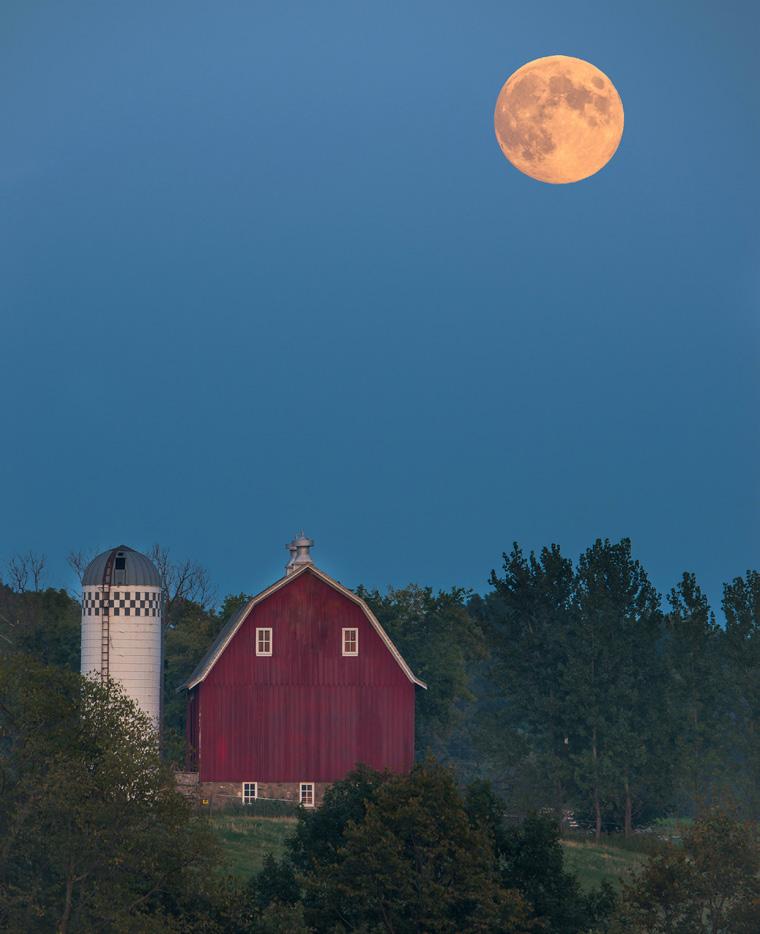

ARBORETUM MAGAZINE // AUGUST • SEPTEMBER 2023 | 11 EVENTS
Photos by Sara Pace
Photo by Don Olson
SCARECROWS IN THE GARDEN
Sept. 16-Oct. 31
Scarecrows in the Gardens adds a festive note to the Arboretum’s autumn displays on the Dahlberg Terrace and Scarecrow Hill. Check out the artistry of the experts from Bachman’s, Arboretum staff and members of the community. Learn more at arb.umn.edu/ events/gardenscarecrows

APPLEFEST

Sept. 23, 10 a.m.-4 p.m.
This brand new event celebrates everything apple at the “Home of the Honeycrisp,” the Arboretum and Horticultural Research Center! Learn all about apple breeding, research, cider making and more from Arboretum experts and try your hand at an apple peeling contest! Then enjoy fresh flavors from local food trucks offering apple-themed fare. Register at arb.umn.edu/events/applefest
AUXILIARY HARVEST SALE
Oct. 6-7, 9 a.m.-4 p.m, and Oct. 8, 11 a.m.-4 p.m.
Save the date for the annual Arboretum Auxiliary Harvest Sale featuring handcrafted harvest-inspired items. Shop from a range of home décor, potpourri, Arboretum wood creations, knitwear for adults and children, beautiful autumnal wreaths and arrangements, cards, toys and many other creative arts made by Auxiliary members. All proceeds benefit the Arboretum. Learn more at arb. umn.edu/auxiliary
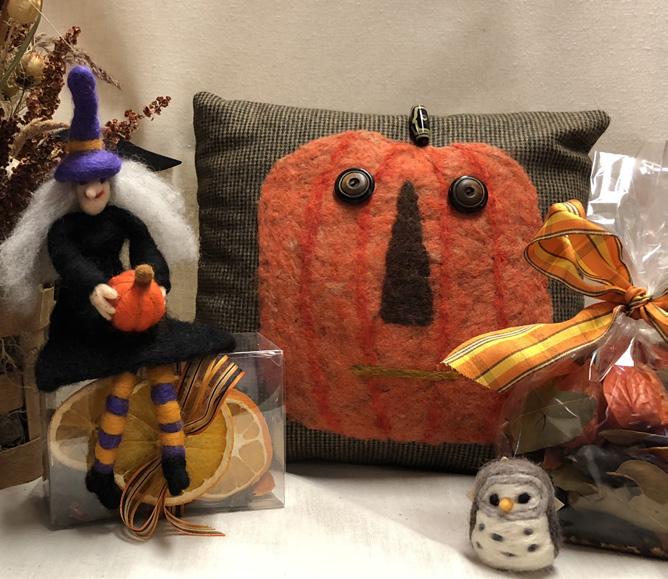
AUXILIARY QUILT RAFFLE
Through Oct. 7
The 2023 Arboretum Auxiliary fund-raising quilt — titled "Minnesota Woodlands" — features a whimsical collection of woodland creatures, flowers, animals and birds of Minnesota. It measures 59" x 75", and is on display in the Oswald Visitor Center Great Hall. Raffle tickets are $2 each. The drawing will be held in the Snyder Auditorium on Oct. 7 as part of the Auxiliary's Annual Harvest Sale. See arb.umn.edu/auxiliary

| ARBORETUM MAGAZINE // AUGUST • SEPTEMBER 2023 12
EVENTS
Photos by (top) Sara Pace; (bottom) Mark MacLennan
Training the next generation of food system leaders
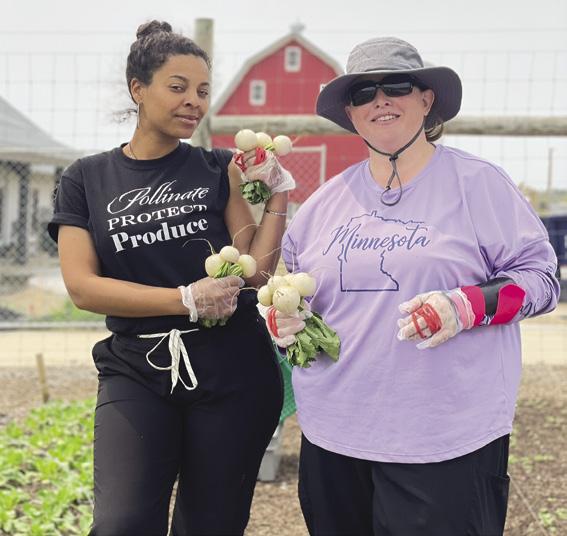

 JILL LEENAY • EDUCATION
JILL LEENAY • EDUCATION
In addition to the crops that thrive at the Farm at the Arb, people and knowledge are also growing just steps away from the Arboretum’s historic Red Barn. Since its inception in 2020, the Farm at the Arb Apprenticeship Program has successfully graduated three cohorts of farm apprentices who have career goals in sustainable horticulture.
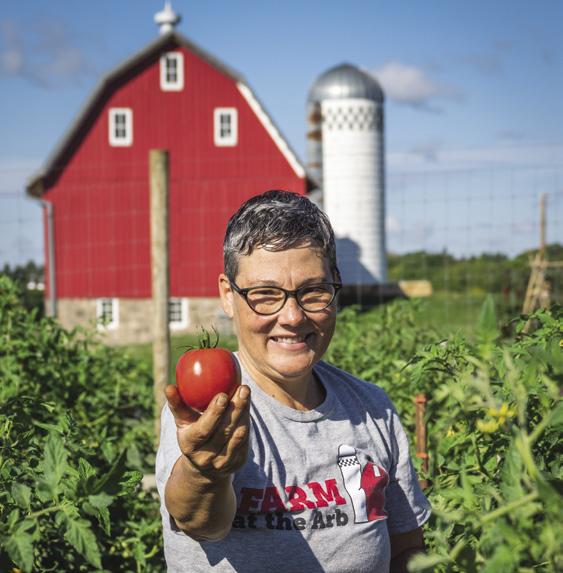
The nine-month apprenticeship program runs from February through October and includes 450 hours of coursework and 725 hours of paid in-the-field training. Apprentices gain the skills, experience and networking opportunities necessary to redefine the next generation of food system leaders. Prospective apprentices who are at least 18 years old with a high school equivalency are encouraged to attend summer information sessions before applying in the fall. Participants pay a coursework fee (with some scholarships available) and earn back the fee during the paid, 14-week on-the-job training period.
The program includes lectures, lab activities and fieldwork to develop an employable and problemsolving grower. Lessons focus on the foundations of sustainable agriculture — horticultural plant science,

soil fertility, pest management, greenhouse production and post-harvest handling techniques. Participants also explore environmentalism and community building. During their paid work experience, apprentices work a minimum of 24 hours per week on a commercial vegetable farm, at the Arboretum or at partner farm sites. According to Tim Wilson, manager of the apprenticeship program, the key to a successful cohort is to recruit apprentices with unique experience from a diversity of backgrounds. Kevin (pictured, left) is a former data scientist and 2022 program graduate who purchased 40 acres in New Germany to grow market produce. Brownson (pictured, top and left) is a 2023 apprentice as well as a community builder and farmer in Minneapolis, who works with youth and aims to start his own foodgrowing movement.
Last year, 18,000 pounds of produce was grown and harvested by the Farm at the Arb Apprenticeship Program and was donated to local food shelves and distributed through a USDA-supported VeggieRx contract that provides free vegetables to people with diet-related diseases. Learn more at arb.umn.edu/learn/farmapprenticeship.
ARBORETUM MAGAZINE // AUGUST • SEPTEMBER 2023 | 13
Photos by Jill Leenay
Apprentices of the Farm at the Arb Apprenticeship Program gain the skills and experience needed to pursue their career goals in sustainable horticulture. Images left from top to bottom: Apprentices Goddess and Janel, Kevin, Brownson and Susanne.
Photo by Sara Pace
Photo by Tim Wilson
EDUCATION
The Arboretum is a wonderful place to learn, thanks to a variety of experts, scenery and plant collections. Prices listed are for members/non-members respectively. See a complete list of classes for adults, children and families at arb.umn.edu under “Learn.” Follow the class links to register or call 612-301-1210.
Watch the Beekeeper at Work
Aug. 13 and Aug. 26, 11-11:20 a.m.
Drop in to get a peek at a day-in-the-life of a beekeeper. Watch — safely from inside the Bee Center — as the beekeeper inspects the Arboretum’s honey bee hives. This event is weather-dependent because bees do not like rain. No advance registration is required; just show up as this is included with daily ticketed Arboretum admission.
A WONDER-FILLED EXPERIENCE (AWE)
Watch the Honey Harvest
Aug. 4, 10 a.m.-noon or 1-3 p.m.
Drop in to see how honey is harvested and bottled through the Honey House viewing windows. No advance registration is required, just show up! This is included with daily ticketed admission.
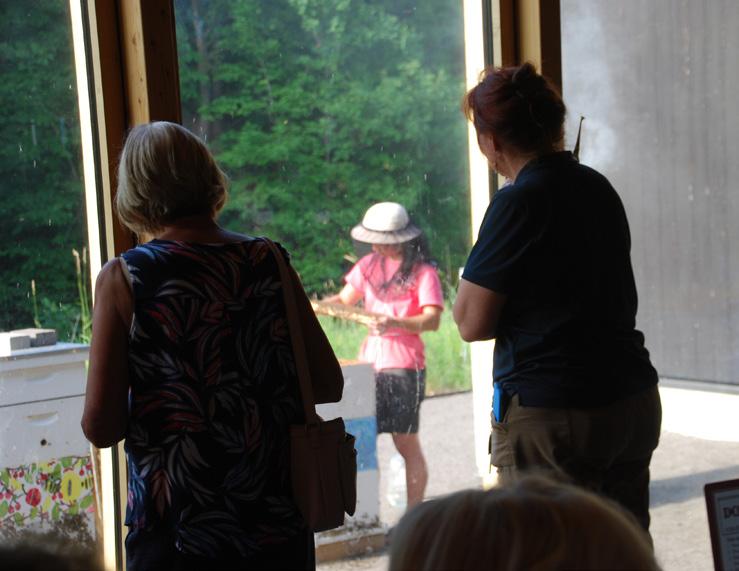

Photographing Magnificent Mushrooms (Online)
Aug. 15, 6:30-8:30 p.m.
Learn how to capture beautiful, high-quality images of mushrooms. In this live webinar, you’ll learn the importance of focus selection and composition, how to shoot in low-light environments and creative and stylistic approaches and techniques for photographing mushrooms!
Cost is $44/$49.
Photographing Spectacular Seeds & Fantastic Fruits (Online)
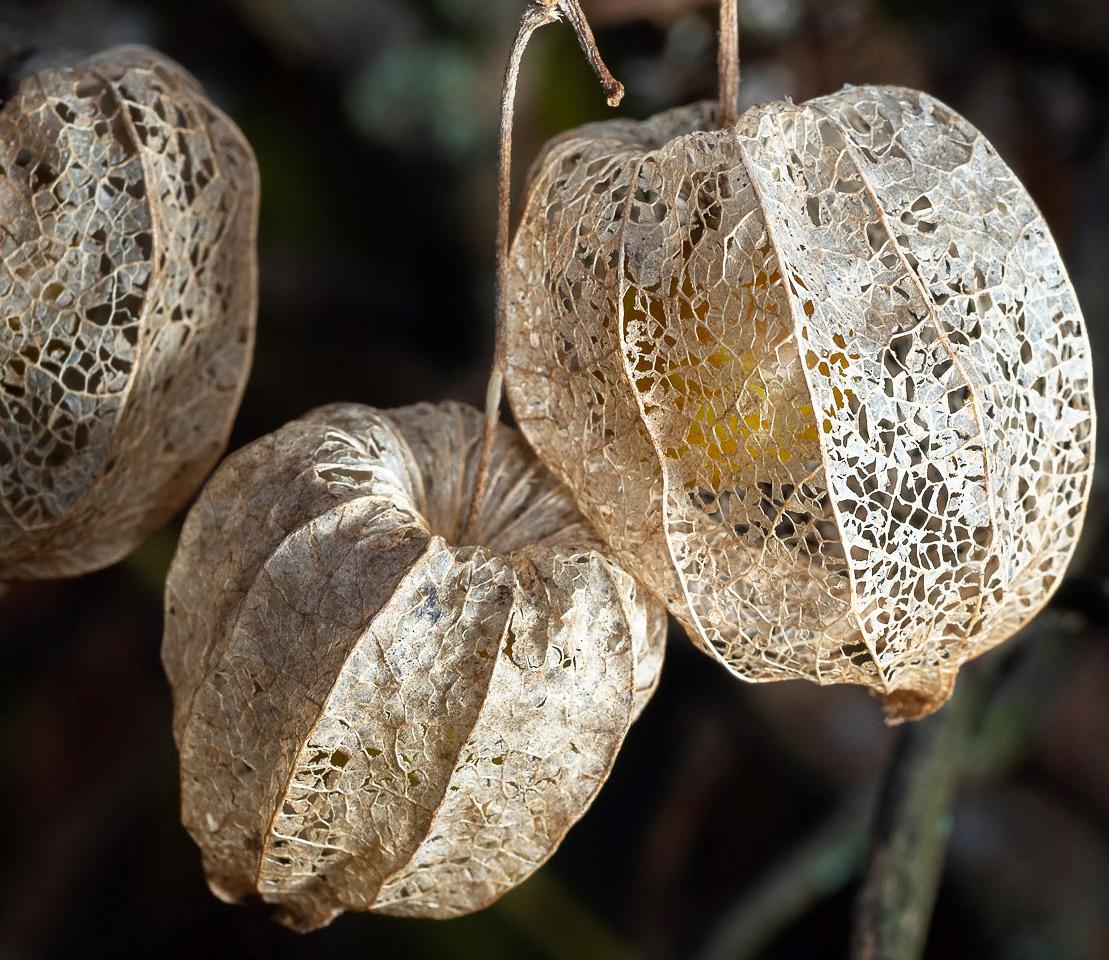
Sept. 7, 6:30-8:30 p.m.
Learn how to find and photograph seeds and fruit in this nature photography class. Plus, discover the importance of focus selection and composition, working with autumnal weather and light and processing your photographs. Cost is $44/$49.
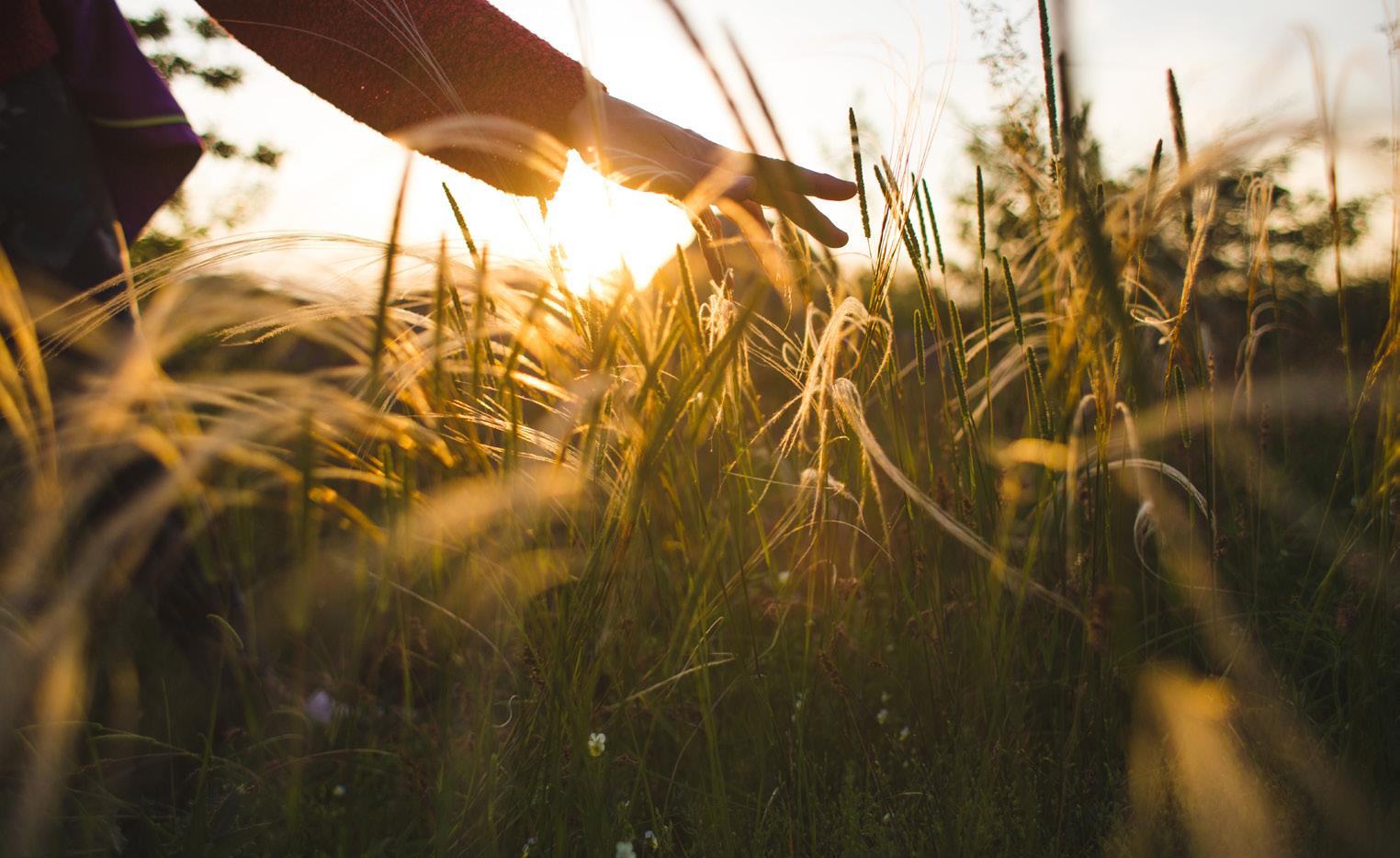
Green Bean Family Garden Time
Aug. 5, Aug. 19, Sept. 9 and Sept. 23, activities available between 9:30-11:30 a.m. Ages 5-11, together with an adult, literally dig into nature! Seasonally themed, staffed activity stations provide at-your-own-pace options like scavenger hunts, garden-inspired creative art projects, science exploration and garden tasks. Cost is $10/child/session (accompanying adults included with daily ticketed admission); all supplies are included.
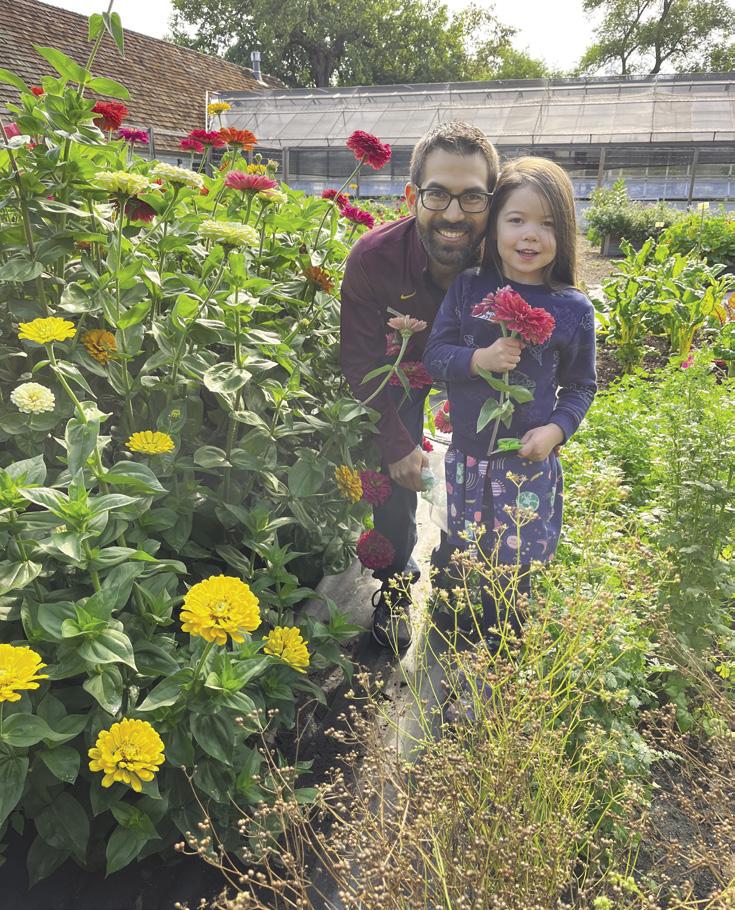
| ARBORETUM MAGAZINE // AUGUST • SEPTEMBER 2023 14
Photo by Karen Campbell
Photo by Laura Cogswell
Photo by Melinda Hooker
Photo by Jill Leenay
Aug. 1, Sept. 5 and Sept. 21, 2-3:15 p.m. Learn the science behind the healing power of nature. Discover breathing and grounding exercises to help calm your mind and enhance your time in a natural environment. Cost is $20/$35.
LEARN
Pollinator Photography: Butterflies, Bees & More!
Sept. 9, 9 a.m.-1 p.m.
Capture amazing images of insect pollinators without frightening them away! Gain tips and practice on focus, composition, shutter speed and lens selection. Cost is $92/$107.
Books in the Garden
Sept. 13, Oct. 11 and Nov. 8, noon-1:30 p.m.
Join the Arboretum’s book club, led by awardwinning University of Minnesota professor emerita of English Toni McNaron, to explore how nature is central to each of us. Series books include “The Outermost House” by Henry Beston, “Owls of The Eastern Ice” by Jonathan Slaght and “Teaching a Stone To Talk” by Annie Dillard. Cost is $59/$105.
Special Access Photography: Shooting the Light Dusk to Dawn
Sept. 15, 5-8 p.m. and Sept. 16, 6-8 a.m. Enjoy private access to the Arboretum grounds before and after public hours to photograph the changing light during dusk and dawn. Discover tips for technical challenges such as bright sun and low light, practice framing techniques for capturing the sunset and receive tips for difficult exposures. Cost is $140/$170.
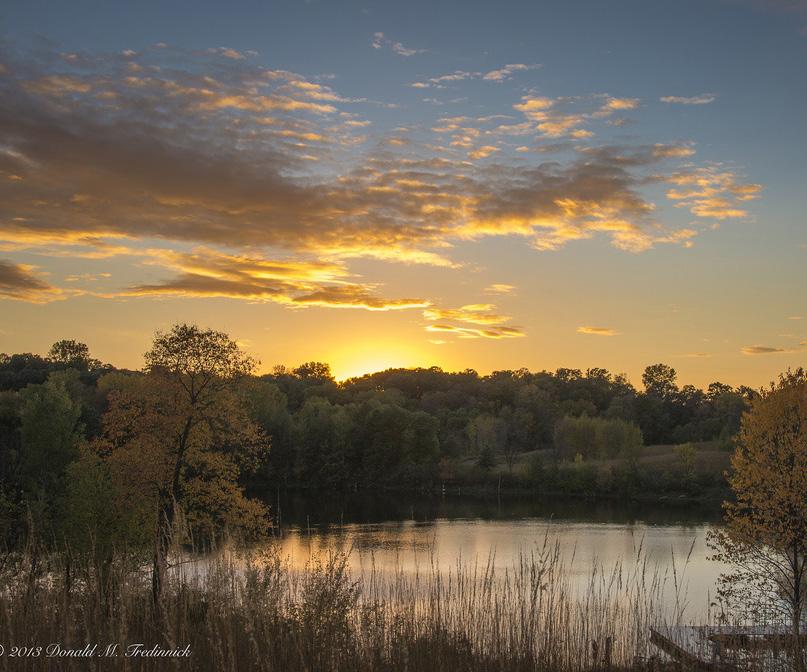
Night Photography Academy (Two-Session Online Class)
Sept. 12 and 14, 7-9 p.m.
Learn the fundamentals of astro-photography so you can shoot the moon, stars and galaxy. You’ll discuss focus, composition, settings, gear, color balancing and recommended apps. Cost is $82/$87.
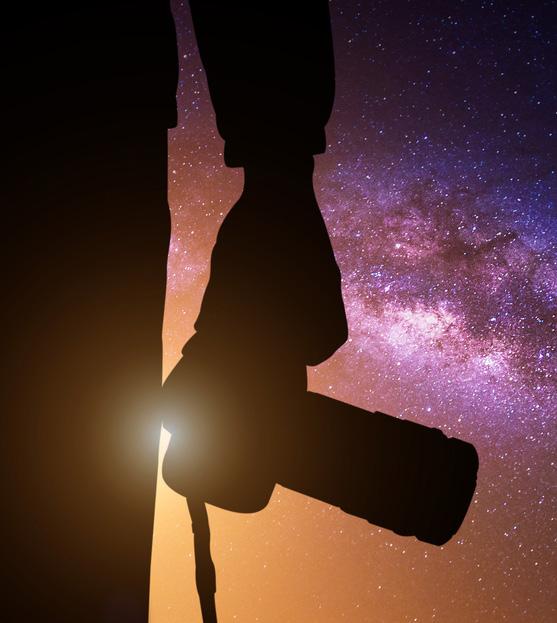
Sept. 24, 1-3:30 p.m.
Learn simple techniques using shape, weight and friction to create impossible-looking balances using ordinary stones. Gain insights on photographing your creations, learn about design and composition, receive helpful tips and practice in class. Cost is $45/$60.

Creating
a Home
Landscape: Sustainable Design Basics for Homeowners
Sept. 16-Nov. 11, 9 a.m.-noon
Over five sessions, learn and apply principles of landscape design, soil and site analysis and proper plant selection for your own yard. Develop a functional, environmentally sound and visually pleasing design unique to your home setting. Cost is $200/$275 (single) or $250/$325 (couples).
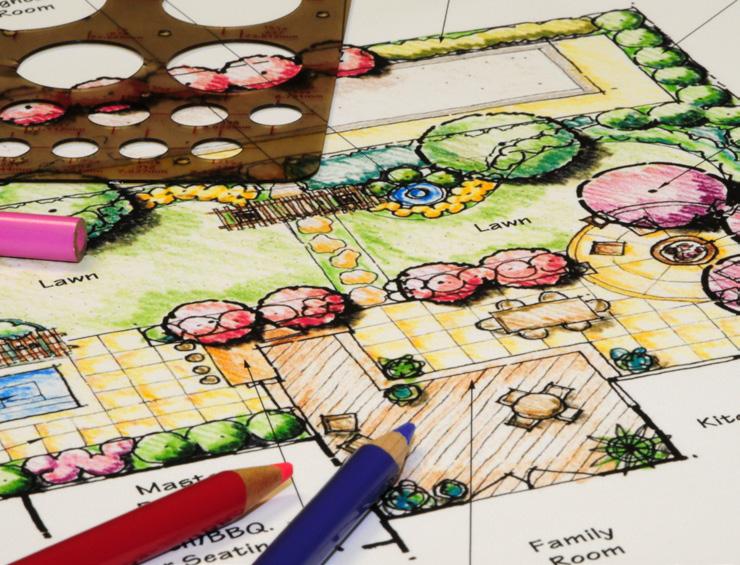
Watercolor Workshop: Leafscapes of the Black Walnut Tree

Sept. 22, 9:30 a.m.-4 p.m.
Watercolor instructor Sonja Hutchinson will guide you through the steps to create a rhythmic painting of the leaf patterns and fruit orbs of the Arboretum's handsome black walnut trees. Some watercolor experience is preferred; bring your own supplies. Cost is $79/$97.
Special Access: Harvest Full Moon Photography
Sept. 28-29, 5-9 p.m.
Get professional secrets for photographing the harvest full moon in this two-session workshop. Understand the best times and places to capture that big moon shot, explore camera settings and proper lenses for successful moon compositions and discuss techniques for detailed, sharp moon pictures. Cost is $232/$262.
Homeschool Day: Apple Harvest
Sept. 29, 1-2:15 p.m.
Students in grades 1-6 use all five senses to become scientific apple testers. Explore how pollination and scientific perseverance come together to develop new apples. Tour the orchard where scientists perform their research. Cost is $15/$18.
ARBORETUM MAGAZINE // AUGUST • SEPTEMBER 2023 | 15 LEARN
THE POWER OF BALANCE: STONE SCULPTURES FOR YOUR GARDEN
Photo by Sonja Hutchinson
Photo by Don Tredinnick
Photo by Peter Juhl
3675 Arboretum Drive
Chaska, Minnesota 55318-9613
Stay in the know!
Follow us on social media.
Art at the Arboretum
For more information on upcoming art exhibitions and events visit arb.umn.edu/art.
REEDY GALLERY
Ballad of the Blue Heron: The Carved Paintings of Kristen Lowe | Through Aug. 20
Inspired by countless hours on the Arboretum grounds and in natural areas nearby, artist Kristen Lowe presents this innovative, large-format exhibition, captivating viewers with flora and fauna tucked into dark, yet ethereal landscapes.
Children of Nature Find Your Wonderland | Aug. 23-Oct. 29
Artist Kristin Maija Peterson’s paintings explore the question of beauty in the natural world, asking: “What is considered beautiful, and what is not?” Meet the artist in the gallery from 11 a.m.-2 p.m. Sept. 23 and Oct. 7, or attend an ArtTalk from 6-8 p.m. on Sept. 21 in the MacMillan Auditorium.
CAFE GALLERY
The Landscapes and Flowers of Stephanie Spencer | Through Aug. 20 Flowers will be blooming inside and out at the Arboretum thanks to Stephanie Spencer’s creations, defined by rich hues and sumptuous images, all made possible with oil paints and a palette knife.
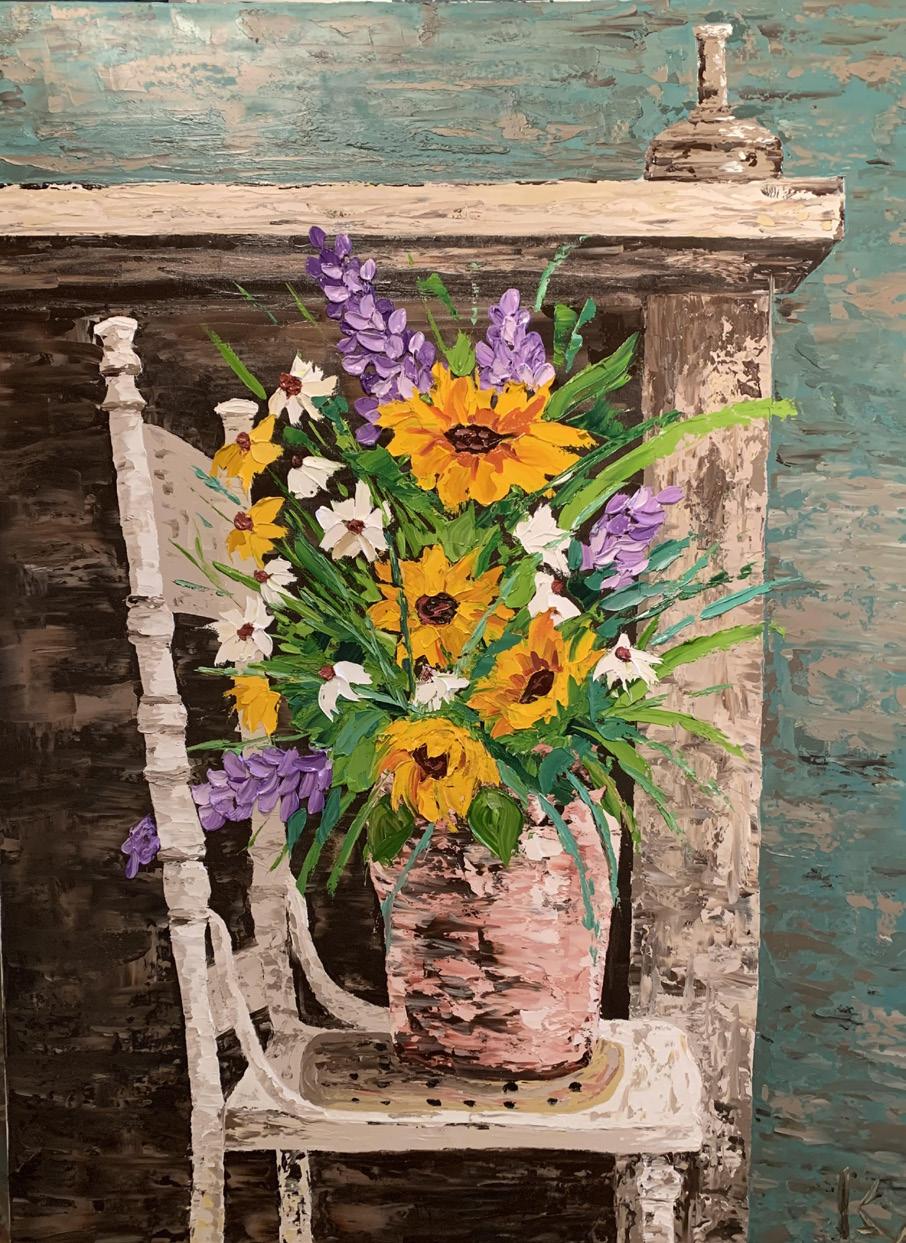
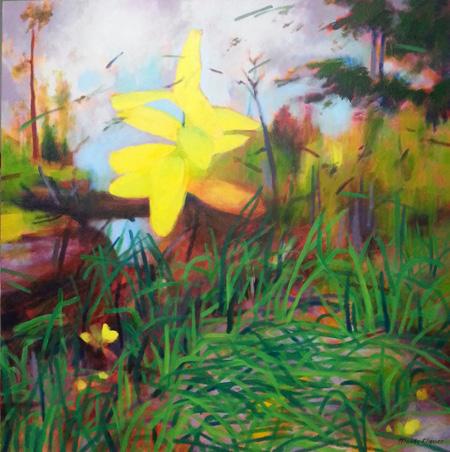
Outdoor Color Visions: the Art of Mandy Chowen | Aug. 23-Oct. 15
Explore the dream-like world of Mandy Chowen’s altered landscapes. Chowen creates her art by layering thin washes of paint color, resulting in a translucent glow that seems to come from within. On Aug. 26, stop by between noon-2 p.m. for a Meet & Greet with the artist to learn about her inspiration and processes.
SKYWAY GALLERY
The 6th-Annual Flora and Fauna Illustrata | Opening August
This collection highlights the important work of artists who create beautiful and scientifically accurate depictions of plants and animals found at the Arboretum.
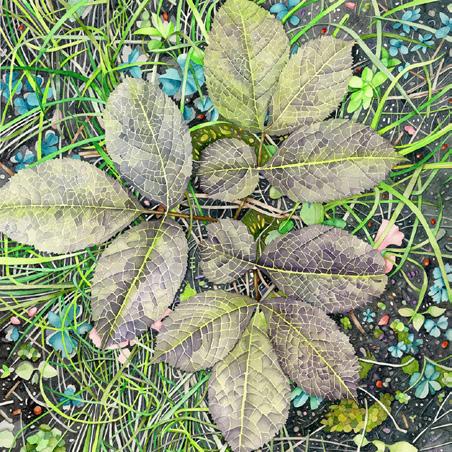
HARRISON SCULPTURE GARDEN
Dakota Sacred Hoop Walk | Ongoing
Explore a stunning, five-stop, augmented reality art exhibit on the Arboretum grounds by Spirit Lake Dakota artist Marlena Myles. A smartphone and the Revelo AR app are required. Learn more at arb.umn.edu/sacredhoopwalk.
"Farm House Flowers" by Stephanie Spencer (top),"Deer Bed Under the Milkweed" by Mandy Chowen (bottom right) and "Little Spring Thing" by Kristin Maija Peterson (bottom left).






























 JILL LEENAY • EDUCATION
JILL LEENAY • EDUCATION














